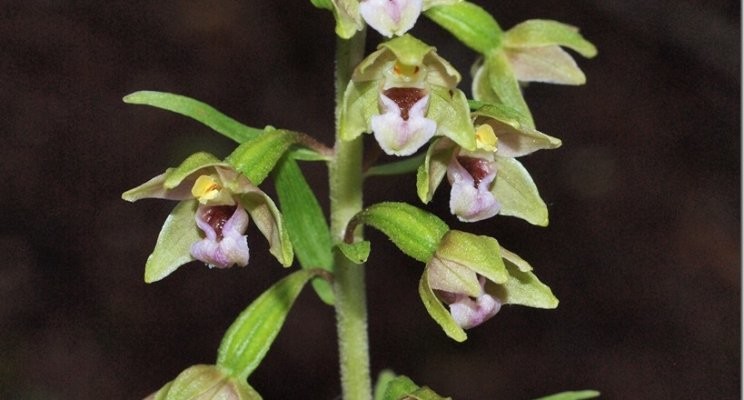
The Notable Flora of Edge Hill University
On the outset, the campus at Edge Hill University, Lancashire, appears to be a typical, monotonous green space, though that is without prior knowledge of its botanical species and floristic assemblages. Four years of botanical recording on campus however, has revealed the presence of over 200 indigenous and archaeophyte vascular plant species in green spaces on campus over meadow compartments, allotments and freshwater body margins. Amongst these 200 species include two nationally rare species, two nationally scarce species, several regionally scarce species and five red-listed taxa.
Probably the most notable discovery at Edge Hill University was the discovery of Dune Helleborine (Epipactis dunensis) in 2014 where it then existed as approximately <10 plants largely restricted to an island within the back halls car park. Following protection and management in collaboration with grounds management staff, the population of Dune Helleborine in 2017 exceeded 200 individuals, now recorded near the Durning Centre in a different part of campus to the north. This is a species of enormous conservation importance given its endemic and nationally scarce status.
Plate 1: Dune Helleborine in flower, 2017 (photo by P.Smith)
Following the initial notable discovery of Dune Helleborine on campus in 2014, an over-summer effort to record all botanical species within the meadows compartment located to the north-east of campus was undertaken. This was in an effort to create a biological records database for Edge Hill (which was then continued from hereon); this yielded over 150 taxa. Most notable species included the discovery of 9 plants of Tubular Water Dropwort (Oenanthe fistulosa) around the pond in this area. This is a species red-listed as 'Vulnerable' throughout England given its state of national decline and is rare on a regional level (see Plate 2). Within the same day of discovery was also the discovery of Large Trefoil (Trifolium aureum). Though non-native, this species is nationally rare and recorded in less than 15 tetrad squares nationally (see Plate 3). Recommendations for the management of the pond with O. fistulosa are underway, and two plants were taken into cultivation for the purpose of the North-West Rare Plant Initiative (NWRPI). See here for more details: www.NWRPI.weebly.com .
Plate 2: Tubular Water Dropwort around the pond within the meadows on campus at Edge Hill
Plate 3: Large Trefoil within the meadows compartment at university
Alongside notable flora within the meadow also included some excellent species elsewhere - an example being the lake beside the health building. This area in Summer yielded over 300 individuals of Dactylorhiza (Marsh Orchid) species, most being the hybrid between Common-Spotted Orchid (D. fuchsii) and Southern Marsh Orchid (D. praetermissa). Also amongst the mass of hybrids included several 'pure' individuals of Southern Marsh Orchid and Northern Marsh Orchid (Dactylorhiza purpurella) which appeared to be doing poorly amidst the hybrids. More excellent than the myriad of orchids beside the lake was probably the re-discovery of the nationally rare True Fox Sedge (Carex vulpina) which appeared to be doing well on the most south-easterly fringe of the lake (see Plate 4).
Plate 4: True Fox Sedge found beside the lake near the Faculty of Health 2017 (photo: P. Smith)
In September, the total count of red-listed species on campus came to just the two (Tubular Water Dropwort and Ragged Robin (Silene flos-cucculi)). These are both declining wetland plants throughout the UK, where drainage of these wetlands is largely to blame for their widespread decline. A visit on the 5th October 2017 to the allotments on campus however, increased the number of red-listed taxa by 150%, yielding three species that are red-listed. These included Field Woundwort (Stachys arvensis) (see Plate 5), Corn Spurrey (Spergula arvensis) (see Plate 6) and Devil's Bit Scabious (Succisa pratensis). Though Devil's Bit Scabious appeared to be an escapee, both the former species appeared to be doing rather well in two of the beds. Both Field Woundwort and Corn Spurrey are local within the region and have a strong reliance upon disturbance and have a low tolerance to herbicide use - hence their decline.
Plate 5: Field Woundwort ('Near Threatened') within allotment compartment (October 2017)
Plate 6: Corn Spurrey ('Vulnerable') within allotment compartment (October 2017)
Though the campus at Edge Hill and habitats on campus perhaps could appear to be ordinary, the number of notable species and sheer diversity from a botanical perspective makes it a much less typical, and more fabulous green space. These aforementioned areas are all identified within the Edge Hill University Biodiversity Action Plan (BAP) and will continue to be managed in a favourable way for wildlife (available online here: https://www.edgehill.ac.uk/biology/files/2017/06/Biodiversity-Action-Plan-for-Edge-Hill-University.pdf).






Director at Milieu Landscape Design Ltd
6yGraham and Joshua Great to see the botanists are using the campus and that there are some good ecological gains. Might I suggest that a colony of dune hellebores is established somewhere safe from future development. Happy to help if needed. Also I suggest Neil Toner , Grounds Manager is involved as he is keen to manage the meadow areas for better diversity.
Owner at Smith & Love Planning Consultants
6yFrancis Hesketh The landscaping and ecological habitat planting was designed by Ian Clare and Chris Forshaw. It formed part of the Green Belt benefits package for the campus extension. Good to see it thriving.
Technical Director at TEP - The Environment Partnership
6yReally interesting account of just what surprises might be right under our noses if we look for them. Some belting photos too. I wonder if Spergula is a bit more common than we think in Lancashire.